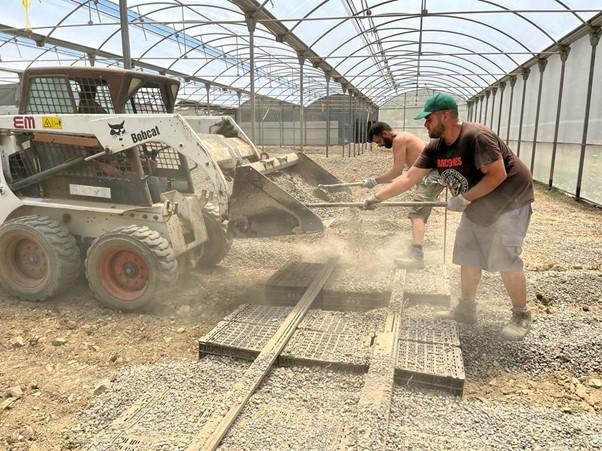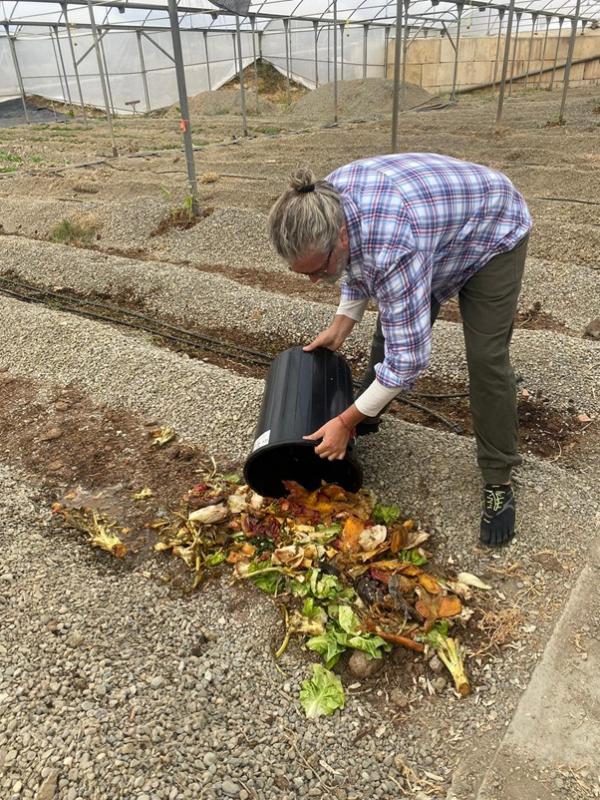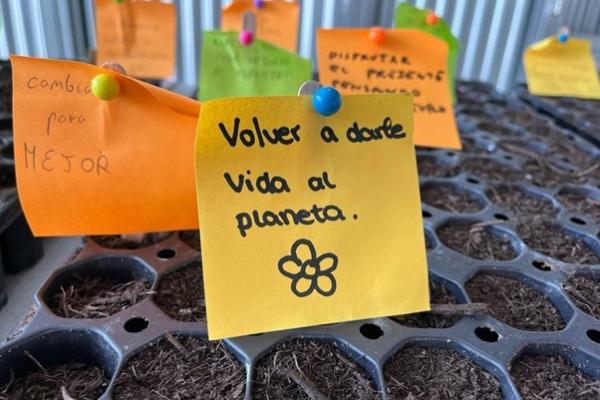Cultivating Consciousness
Cultivating Consciousness
How scarce water and a commitment to re-imagining the interplay of agriculture, nature, community, and life on a farm in Spain is pointing the way toward a new practices and flourishing in an area facing abandonment.
We arrived in the sleepy town of Guaro on a crisp Autumn morning, as dawn was breaking over the rolling olive and almond groves. We crept down the hill and turned a corner and a greenhouse nestled among trees, tall grasses and wildflowers came into view. Outside, the entrance was framed with bougainvillaea and cacti. Inside was a space that would give the hippest of warehouses in East London a run for their money. Minimal and chic, dotted with upcycled furniture, contemporary art and a profusion of houseplants–this is about as far from your average Andalucian polytunnel as it gets.[1]
It’s hard to believe that just six months ago the whole plot was a wasteland–abandoned by its previous owners, it had become a favourite spot for fly-tipping (i.e. illegal dumping). But since receiving the keys on the 18th of May this year, the three-man team who make up Greenhouse Regenerative Lab (GRL) have worked miracles to breathe new life into this land.

Alejandro César Orioli Dobler, GRL’s coordinator and founder of its parent organisation, Fundación Arboretum, has been an ecologist and activist for the past 30 years. “My aim,’ he says ‘ is to care for life; and by that I don’t just mean human life but every manifestation of life.” His dream for GRL was to create a project that could serve as a reference and inspiration for others. He explains:
“We’re growing vegetables but really what we’re doing is cultivating consciousness. Of course, we’re helping our members to feed their families and we’re helping to feed the local population, but beyond that we’re showing people that they can grow food regeneratively and save water. This is a challenge we are already facing, which is growing more serious by the day.”
Water, as it happens, is the inspiration for this project. According to Greenpeace, more than 75% of Spain is at risk of desertification due to climate change and soil degradation, and its Southernmost region, Andalucia, particularly so. The Guadalhorce Valley, where GRL is located, was once spared from this phenomenon thanks to its unique microclimate. However in recent years soaring temperatures and a steep increase in demand for water-intensive monocultures like avocado and mango have triggered severe water shortages, which show no signs of abating. ‘Every year the valley runs out of water, and smallholders lose their crops because they can’t irrigate them,’ Alejandro explains.
Since the region’s main economic activities–agriculture, agri-food and tourism–depend heavily on water, there is little political will to tighten regulations or to discourage the disproportionate use of this finite resource. Faced with this 0vacuum, Alejandro and his team went out in search of alternative solutions: “And this is the challenge we have taken on, to be a project, a laboratory, where we can demonstrate in three or four years' time, the viability of this innovative way of doing things.”


The results are impressive: they have created the first regeneratively-farmed greenhouse in Spain. Covering an area of 6,000 m2, in the year ahead GRL expects to produce 15,000 kilos of final produce per month using 30%-40% less water than an open-air agricultural structure of its size. It currently produces more than 15 varieties of vegetables (hoping to increase this to 55 by the end of the year), as well as six varieties of edible flowers and eight varieties of herbs all separated by biological corridors containing flora that provide a home to a multitude of pollinators and auxiliary insects. The innovative, ecological design combines cutting-edge technology–with a world-class irrigation system and high-precision soil and plant humidity analysis tools–as well as adaptations of Persian techniques, such as the aerial well, that were used in ancient times and even known to the Mesopotamians. Toblerone-shaped rows of gravel (stone bunding) line each row of crops; they help to prevent weeds, to regulate the temperature of the soil beneath them and, most importantly, to recycle water, which they filter down from humid air that gets is trapped inside the bunding and condenses as it touches the cool surface of the stones. This recycled water irrigates the crops, cutting down on the need to source water from outside the system.

To be regenerative it has to be in all domains
As its name suggests, GRL serves as a lab where the team prototype and test other types of regenerative techniques and solutions. They are currently trialling five types of natural fertilisers including compost made from sheep manure, horse manure, chicken manure (all sourced locally), a food waste mix transformed by earthworms (kept in a hotel on site), as well as microalgae[1] [2] . In case you are wondering, microalgae are rapidly-growing photosynthetic microorganisms that increase soil productivity by increasing its nutrient content. Unlike conventional fertilisers they do not pollute, add heavy metals or have carcinogenic effects but instead transform pollutants into high-value biomass, including nitrogen, potassium, iron, zinc and other vitamins. “As well as being sustainable, ecological and pollution free, they are better for soil health, human health and for biodiversity,” explains Alejandro, who installed a microalgae reactor in the greenhouse after time spent studying at Spain’s biggest microalgae producer Algaenergy. “Algae are the primary natural carbon fixers’ he continues, ‘meaning that they transform CO2 into oxygen, and they do it 10 times faster than any other plant on the planet.”

As well as promoting regenerative food production, GRL is weaving resilient local supply chains for ecological producers. Its parent organisation Fundación Arboretum set up a community supported agriculture scheme (CSA) back in 2016, which is currently feeding 400 local people a day directly from local producers. Recipients include a company canteen, a fruit and vegetable basket scheme and a scheme for people in need. There are imminent plans to expand and migrate it to GRL, which is also in the process of setting up a conscious consumption group, Más alimentos Menos agua (More food, Less water, MaMa), whose members’ fees will partly support research on reducing water use in food production through rainfed cereals such as fonio and sorghum, as well as various horticultural crops.
The scheme also tackles the problem of food waste by collecting organic matter from its consumers and returning to the greenhouse where it is turned into compost through a vermicompost and then enters back into the production loop.

But GRL’s ambitions don’t stop at food production, it is a space for research, exploration and the empowerment of people who want to develop a regenerative ecosystem and culture. It’s seeking to promote systemic health, resilience and sustainability in the local bioregion, while innovating on globally-relevant scale. This means looking at every aspect–organisational, economic, social–of the ecosystem in which it operates.
Starting from within, GRL has integrated consciousness into its organisational design, adjusting the internal organisation to a 'biocentric paradigm' with a focus on caring for life. But what does 'caring for life' inside the organisation mean? ‘To begin with, we don't have a hierarchy, we have a structure where responsibilities are distributed, but it is not a hierarchy. Decision-making is shared, joint and consensual. Salaries are transparent, as are costs and profits. We have a common regenerative purpose which is for the Lab to generate an income-—and therefore be productive—to sustain itself, as well as to care for ourselves". Within this framework, the team participates in two hours of training in non-violent communication each week, with the aim of fostering understanding and collaboration through respect and deep connection.

When asked why this approach is so important, Alejandro explains:
"The current paradigm has led us to the state of collapse we are in and part of this paradigm is organisational business models in which there are hierarchies, a lack of transparency, power relations, where inequality is generated, life is not taken care of, trust is not nurtured, and so on. What is the point of growing regenerative vegetables if a person at the ‘top’ is paid 5,000 euros a month and a person at the ‘bottom’ can’t get through the month? That is not regenerative holistically. To be regenerative it has to be in all domains".

Looking to the meso level, GRL has been dreaming up strategies to help repair and renew the social fabric of a dwindling rural community, where traditional livelihoods (i.e. farming the land) present great challenges for an ageing population and hold little appeal for younger generations. Its seed bank Semillas con Memoria (Seeds with Memory) is helping to safeguard local cultural heritage and establish connections with older community members by involving them in a project to bring back the flavours of their youth through reclaiming local heirloom seed varieties on the brink of extinction. Although initially inspired by GRL and Fundación Arboretum’s partners Red Andaluza de Semillas (RAS) and Red Guardianes de Semillas in Ecuador, this initiative has garnered media attention through the work of Michelin star chefs, the Roca brothers who have even produced a documentary on the subject.

In an effort to connect with children and their families, GRL is partnering with Guaro’s local primary school to supply its kitchen with locally grown, regenerative organic produce. Until now, the autonomous government of Andalucia has been supplying the school with weekly kits of frozen vegetables, which are neither ecological nor locally-produced. But as of January 20, the greenhouse will be sending freshly-grown vegetables directly to the school’s kitchen and offering cost-price vegetable baskets to the families of the 300 students. It is also creating an experiential garden on its premises where children can learn about nature and the importance of growing their own food through play, experimentation and contact with the soil.

In addition to its onsite activities and initiatives, GRL is collaborating with a group of researchers and economists connected to Schumacher College on a long-term project to map the local economic landscape, connect with local stakeholders and engage in a participatory process to explore, envision and co-create collaborative, synergistic visions for the future.
One of the most novel initiatives cooked up by GRL so far is an Incubator space for farmers who are new to regenerative or agroecological growing. Spanning social and economic dimensions, the incubator will host up to ten farmers on parcels of 200 m2 where they will receive training in cutting-edge regenerative greenhouse-based production. As well as the space and training in innovative farming practices and techniques, their rent will include technical assistance, business mentoring as well as support with the direct marketing of their produce. Alejandro hopes the incubator will not only create jobs and attract young, ethically-minded producers to the area, but that it will inspire and enable those who receive incubation to set up their own projects, seeding a new generation of regenerative innovators in the bioregion and beyond.

The only thing that can change reality is action
But what is the force driving this immense effort to breathe life back into every aspect of the ecosystem? Alejandro explains:
“The only thing that can change reality is action. I have that tattooed on my body because I really feel that if we don't act, nothing will change. One thing that deep activists have in common, in addition to commitment, is courage: you are trying to generate a solution to a problem that you’ve identified and you commit yourself to that solution. You don’t just denounce the problem because it’s very easy to criticise, but what’s hard and what is necessary is to offer a solution, to suggest a pathway.”
He believes that activism starts from within: “You start to question your own behaviours, your own values, your own relationships. A person like Satish Kumar or the Dalai Lama or Gandhi might inspire you–they are like the spark that lights the fire but [the ingredients] for that fire to burn are within you.” And above all else, solutions and pathways are exactly what GRL is offering. Not only are Alejandro and his team cultivating consciousness among the people they reach, they are also cultivating hope through innovation and human relations. And perhaps this hope will be the match that sparks the fire of activism in the heart of a new generation.


